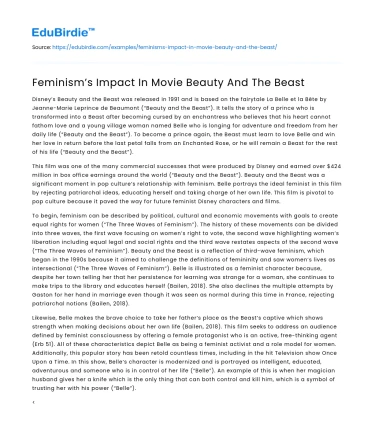Disney’s Beauty and the Beast was released in 1991 and is based on the fairytale La Belle et la Bête by Jeanne-Marie Leprince de Beaumont (“Beauty and the Beast”). It tells the story of a prince who is transformed into a Beast after becoming cursed by an enchantress who believes that his heart cannot fathom love and a young village woman named Belle who is longing for adventure and freedom from her daily life (“Beauty and the Beast”). To become a prince again, the Beast must learn to love Belle and win her love in return before the last petal falls from an Enchanted Rose, or he will remain a Beast for the rest of his life (“Beauty and the Beast”).
This film was one of the many commercial successes that were produced by Disney and earned over $424 million in box office earnings around the world (“Beauty and the Beast”). Beauty and the Beast was a significant moment in pop culture’s relationship with feminism. Belle portrays the ideal feminist in this film by rejecting patriarchal ideas, educating herself and taking charge of her own life. This film is pivotal to pop culture because it paved the way for future feminist Disney characters and films.
Save your time!
We can take care of your essay
- Proper editing and formatting
- Free revision, title page, and bibliography
- Flexible prices and money-back guarantee
To begin, feminism can be described by political, cultural and economic movements with goals to create equal rights for women (“The Three Waves of Feminism”). The history of these movements can be divided into three waves, the first wave focusing on women’s right to vote, the second wave highlighting women’s liberation including equal legal and social rights and the third wave restates aspects of the second wave (“The Three Waves of Feminism”). Beauty and the Beast is a reflection of third-wave feminism, which began in the 1990s because it aimed to challenge the definitions of femininity and saw women’s lives as intersectional (“The Three Waves of Feminism”). Belle is illustrated as a feminist character because, despite her town telling her that her persistence for learning was strange for a woman, she continues to make trips to the library and educates herself (Bailen, 2018). She also declines the multiple attempts by Gaston for her hand in marriage even though it was seen as normal during this time in France, rejecting patriarchal notions (Bailen, 2018).
Likewise, Belle makes the brave choice to take her father’s place as the Beast’s captive which shows strength when making decisions about her own life (Bailen, 2018). This film seeks to address an audience defined by feminist consciousness by offering a female protagonist who is an active, free-thinking agent (Erb 51). All of these characteristics depict Belle as being a feminist activist and a role model for women. Additionally, this popular story has been retold countless times, including in the hit Television show Once Upon a Time. In this show, Belle’s character is modernized and is portrayed as intelligent, educated, adventurous and someone who is in control of her life (“Belle”). An example of this is when her magician husband gives her a knife which is the only thing that can both control and kill him, which is a symbol of trusting her with his power (“Belle”).
Another well-known example of this is the 2017 re-imagined version of this film, which stars Emma Watson as Belle, who is a famous feminist activist (Gray, 2017). This film highlights Belle wanting to share her knowledge with other girls and turns her into an inventor which gives her strong ambition and a sense of self (Gray, 2017). These modern adaptations of this story prove the strong impact that this film has had on the history of pop culture’s relationship with feminism. Furthermore, this film resulted in the making of many other Disney films that portray feminist ideals and characters. For instance, Princess Jasmine in Aladdin refuses to be forced into marriage and fights against traditions and expectations (Bailen, 2018). Another example is Pocahontas who chooses her tribe over love and teaches John Smith about her culture (Bailen, 2018). Beauty and the Beast has historically been predominantly a woman's story and has inspired many to follow further proving the relevance of feminism in society throughout the decades (Erb 53).
To conclude, Beauty and the Beast took many ideas surrounding feminist theory and highlighted it through an animated film that was targetted to young women and emphasizes Belle as a role model. Belle’s interest in learning and reading, as well as her lack of interest in forced marriage and patriarchy presents her as being an empowered Disney princess. This film is very important to the history of pop culture because it was one of the first Disney films to put a spotlight on feminism and started the conversation about this movement which sparked many films that followed. It is still a relevant film in society today because feminism is still being mentioned and talked about in countless other films, television shows and other forms of pop culture. Belle’s perseverance can be found in women everywhere!






 Stuck on your essay?
Stuck on your essay?

